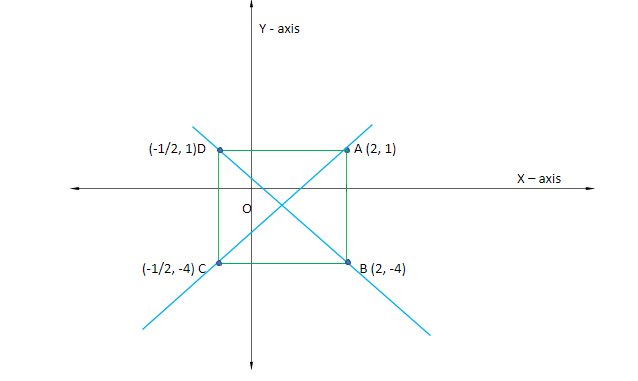
The diagonals of a square are along the pair of lines whose equation is
A.
B.
C.
D.
Answer
525k+ views
Hint: We will draw the plot of the square on the graph and from reference of the graph, we will substitute
Complete step-by-step answer:
We are given that the diagonals of a square are along the pair of lines whose equation is
One of the vertices of the square is given as
Now, we know that if one vertex is
Factoring this equation, we will get the values of y as:
Therefore,
Again, putting the value of
Factorising this equation for the value of x, we get
Therefore,
So, the two vertices adjacent to
The graph of the square and pair of the lines can be represented as:

Here, ABCD is the square whose diagonals are along the pair of lines with equation
Now, both of these vertices don't match with any of the given options. So, we will simplify these vertices. We can shift the vertices in such a manner that they are adjacent to the vertex
Looking at the options, we get that option (C) and option (D) are correct.
Note: In this question, be careful when we have used
Complete step-by-step answer:
We are given that the diagonals of a square are along the pair of lines whose equation is
One of the vertices of the square is given as
Now, we know that if one vertex is
Factoring this equation, we will get the values of y as:
Therefore,
Again, putting the value of
Factorising this equation for the value of x, we get
Therefore,
So, the two vertices adjacent to
The graph of the square and pair of the lines can be represented as:

Here, ABCD is the square whose diagonals are along the pair of lines with equation
Now, both of these vertices don't match with any of the given options. So, we will simplify these vertices. We can shift the vertices in such a manner that they are adjacent to the vertex
Looking at the options, we get that option (C) and option (D) are correct.
Note: In this question, be careful when we have used
Recently Updated Pages
Full Form: Updated List (2025) of Important Abbreviations You Should Know

ITES Full Form: Meaning, Difference, Examples & Exam Relevance

PCB Full Form: Meaning, Uses & Subjects Explained (2025)

PAN Full Form: Meaning, Uses & Exam Importance Explained

IT Full Form: Information Technology Explained for Students

OTG Full Form: Oven Toaster Grill & On-The-Go Explained

Trending doubts
Difference Between Plant Cell and Animal Cell

Name 10 Living and Non living things class 9 biology CBSE

Fill the blanks with the suitable prepositions 1 The class 9 english CBSE

The highest mountain peak in India is A Kanchenjunga class 9 social science CBSE

What is the Full Form of ISI and RAW

Write the 6 fundamental rights of India and explain in detail




